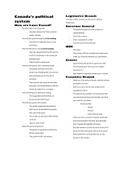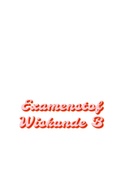1BV00 - Fundamentals of
business information systems
Essentials of management information systems
Week 1:
Chapter 1: business information systems in your career
1-1 why are information systems so essential for running and managing a business
today?
If you and your business aren’t connected to the internet, chances are you are not being
as e ective as you could be.
Supply chains have become faster paced, with companies of all sizes depending on the
delivery of just-in-time inventory. If you are not part of this new supply chain management
economy, chances are your business is not as e cient as it could be.
What makes management information systems the most exciting topic in business is the
continual change in technology, management use of the technology, and the impact on
business succes.
In the technology area are three interrelated changes:
1. The mobile digital platform composed of smartphones and tablet devices
2. The growing business use of big data, including the Internet of Things (IoT) driven
by billions of data-producing sensors
3. The growth in cloud computing, by which more and more business software runs
over the internet
The strength of cloud computing and the growth of the mobile digital platform mean that
organizations rely more telework, remote work, and distributed decision making. This
same platforms means rms can outsource more work and rely on markets (rather than
employees) to build value. It also means that rms can collaborate with suppliers and
customers to create new products or make existing products more e ciently.
The internet and global communications have made the world at. Because of
information systems, the costs of operating and transacting on a global scale have been
greatly reduced.
Business drivers of information systems:
• Operational excellence
• New products, services, and business models
• Customer and supplier intimacy
• Improved decision making
• Competitive advantage
• Survival
ff fi fi ffi fl ffi
, 1-2 what exactly is an information system? How does it work? What are its people,
organizational, and technology components?
Information technology (IT) = all the hardware and software that a rm needs to use to
achieve its business objectives.
Information system (IS) = a set of interrelated components that collect (or retrieve),
process, store, and distribute information to support decision making, coordinating, and
control in an organization
Information = data that have been shaped into a form that is meaningful and useful to
human beings
Data = streams of raw facts representing events occurring in organizations or the physical
environment before they have been organized and arranged into a form that people can
understand and use
Feedback = output that is returned to appropriate members of the organization to help
them evaluate or correct the input stage
Three activities in an information system:
Input captures raw data from within the organization or its external environment,
processing converts this raw data into a meaningful form, output transfers the
processed information to people who will use it.
Information systems literacy = behavioral as well as a technical approach to studying
information systems
Computer literacy = focuses primarily on knowledge of information technology
Management information systems (MIS) = tries to achieve this broader information
systems literacy, deals with behavioral issues as well as technical issues surrounding the
development, use and impact of information systems used by managers and employees
in the rm
fi fi
, Dimensions of information systems:
• organizations (accomplishes and coordinates work through this structured hierarchy
and through its business processes)
- Business processes: logically related tasks and behaviors for accomplishing work
• Developing a new product
• Hiring a new employee
- Culture: fundamental set of assumptions, values, and ways of doing things that
has been accepted by most of its members
• People (a business is only as good as the people who work there and run it)
- Technology is relatively inexpensive these days, but people are the only ones
capable of business problem solving and converting information technology into
useful business solution
• Information technology
- Computer hardware
- Computer software
- Data management technology: software governing the organization of data on
physical storage media
- Networking and telecommunications technology: consisting of both physical
devices and software, links the various pieces of hardware and transfers data from
one physical location to another
• Network: links two or more computers to share data or resources
• Internet: global ‘ network of networks’
• World Wide Web: service provided by the internet that uses universally
accepted standards for storing, retrieving, formatting, and displaying
information in a page format on the internet
• Intranet: internal corporate networks based on internet technology
• Extranets: private intranets extended to authorized users outside the
organizations
All of these technologies, along with the people required to run and manage them
represent resources that can be shared throughout the organization and constitute the
rm’s information technology (IT) infrastructure.
1-3 how will a four-step method for business problem solving help you solve
information system-related problems?
Problem solving process:
• Problem identi cation: de ne the problem
• Solution design: design multiple solutions
• Solution evaluation and choice: choose the best solution
• Implementation: implementing the chosen solution and measure the outcomes,
feedback
-> change management: many techniques used to bring about successful change
in a business
Critical thinking = the sustained suspension of judgment with an awareness of multiple
perspectives and alternatives
fi
fi fi
business information systems
Essentials of management information systems
Week 1:
Chapter 1: business information systems in your career
1-1 why are information systems so essential for running and managing a business
today?
If you and your business aren’t connected to the internet, chances are you are not being
as e ective as you could be.
Supply chains have become faster paced, with companies of all sizes depending on the
delivery of just-in-time inventory. If you are not part of this new supply chain management
economy, chances are your business is not as e cient as it could be.
What makes management information systems the most exciting topic in business is the
continual change in technology, management use of the technology, and the impact on
business succes.
In the technology area are three interrelated changes:
1. The mobile digital platform composed of smartphones and tablet devices
2. The growing business use of big data, including the Internet of Things (IoT) driven
by billions of data-producing sensors
3. The growth in cloud computing, by which more and more business software runs
over the internet
The strength of cloud computing and the growth of the mobile digital platform mean that
organizations rely more telework, remote work, and distributed decision making. This
same platforms means rms can outsource more work and rely on markets (rather than
employees) to build value. It also means that rms can collaborate with suppliers and
customers to create new products or make existing products more e ciently.
The internet and global communications have made the world at. Because of
information systems, the costs of operating and transacting on a global scale have been
greatly reduced.
Business drivers of information systems:
• Operational excellence
• New products, services, and business models
• Customer and supplier intimacy
• Improved decision making
• Competitive advantage
• Survival
ff fi fi ffi fl ffi
, 1-2 what exactly is an information system? How does it work? What are its people,
organizational, and technology components?
Information technology (IT) = all the hardware and software that a rm needs to use to
achieve its business objectives.
Information system (IS) = a set of interrelated components that collect (or retrieve),
process, store, and distribute information to support decision making, coordinating, and
control in an organization
Information = data that have been shaped into a form that is meaningful and useful to
human beings
Data = streams of raw facts representing events occurring in organizations or the physical
environment before they have been organized and arranged into a form that people can
understand and use
Feedback = output that is returned to appropriate members of the organization to help
them evaluate or correct the input stage
Three activities in an information system:
Input captures raw data from within the organization or its external environment,
processing converts this raw data into a meaningful form, output transfers the
processed information to people who will use it.
Information systems literacy = behavioral as well as a technical approach to studying
information systems
Computer literacy = focuses primarily on knowledge of information technology
Management information systems (MIS) = tries to achieve this broader information
systems literacy, deals with behavioral issues as well as technical issues surrounding the
development, use and impact of information systems used by managers and employees
in the rm
fi fi
, Dimensions of information systems:
• organizations (accomplishes and coordinates work through this structured hierarchy
and through its business processes)
- Business processes: logically related tasks and behaviors for accomplishing work
• Developing a new product
• Hiring a new employee
- Culture: fundamental set of assumptions, values, and ways of doing things that
has been accepted by most of its members
• People (a business is only as good as the people who work there and run it)
- Technology is relatively inexpensive these days, but people are the only ones
capable of business problem solving and converting information technology into
useful business solution
• Information technology
- Computer hardware
- Computer software
- Data management technology: software governing the organization of data on
physical storage media
- Networking and telecommunications technology: consisting of both physical
devices and software, links the various pieces of hardware and transfers data from
one physical location to another
• Network: links two or more computers to share data or resources
• Internet: global ‘ network of networks’
• World Wide Web: service provided by the internet that uses universally
accepted standards for storing, retrieving, formatting, and displaying
information in a page format on the internet
• Intranet: internal corporate networks based on internet technology
• Extranets: private intranets extended to authorized users outside the
organizations
All of these technologies, along with the people required to run and manage them
represent resources that can be shared throughout the organization and constitute the
rm’s information technology (IT) infrastructure.
1-3 how will a four-step method for business problem solving help you solve
information system-related problems?
Problem solving process:
• Problem identi cation: de ne the problem
• Solution design: design multiple solutions
• Solution evaluation and choice: choose the best solution
• Implementation: implementing the chosen solution and measure the outcomes,
feedback
-> change management: many techniques used to bring about successful change
in a business
Critical thinking = the sustained suspension of judgment with an awareness of multiple
perspectives and alternatives
fi
fi fi







